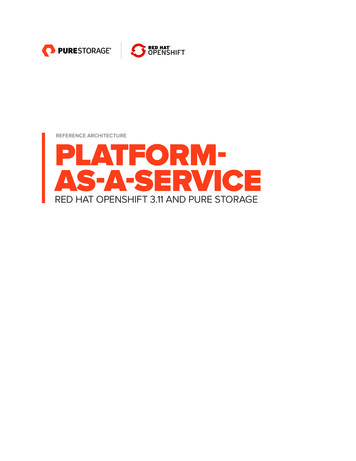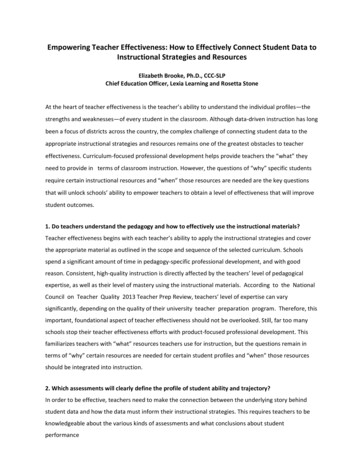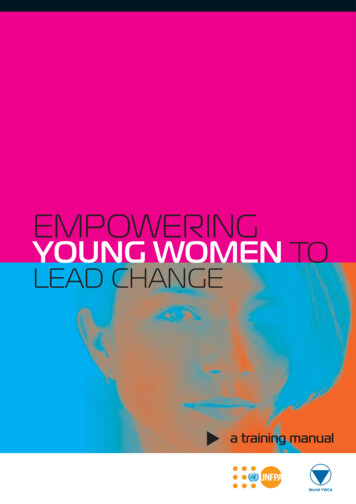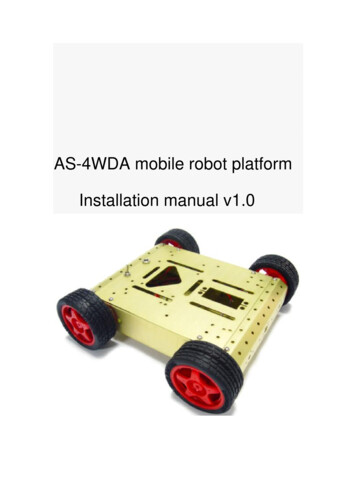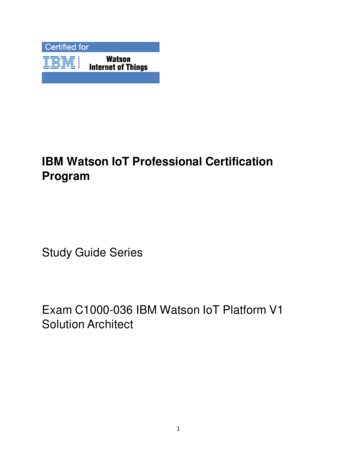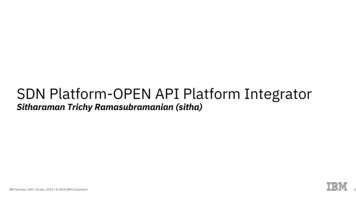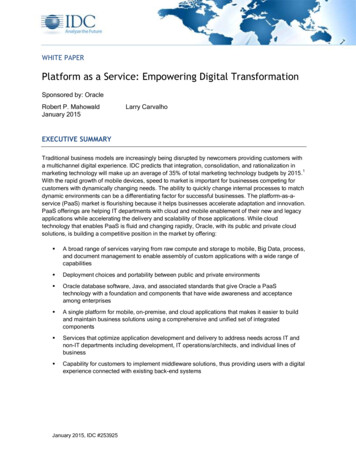
Transcription
WHITE PAPERPlatform as a Service: Empowering Digital TransformationSponsored by: OracleRobert P. MahowaldJanuary 2015Larry CarvalhoEXECUTIVE SUMMARYTraditional business models are increasingly being disrupted by newcomers providing customers witha multichannel digital experience. IDC predicts that integration, consolidation, and rationalization in1marketing technology will make up an average of 35% of total marketing technology budgets by 2015.With the rapid growth of mobile devices, speed to market is important for businesses competing forcustomers with dynamically changing needs. The ability to quickly change internal processes to matchdynamic environments can be a differentiating factor for successful businesses. The platform-as-aservice (PaaS) market is flourishing because it helps businesses accelerate adaptation and innovation.PaaS offerings are helping IT departments with cloud and mobile enablement of their new and legacyapplications while accelerating the delivery and scalability of those applications. While cloudtechnology that enables PaaS is fluid and changing rapidly, Oracle, with its public and private cloudsolutions, is building a competitive position in the market by offering: A broad range of services varying from raw compute and storage to mobile, Big Data, process,and document management to enable assembly of custom applications with a wide range ofcapabilities Deployment choices and portability between public and private environments Oracle database software, Java, and associated standards that give Oracle a PaaStechnology with a foundation and components that have wide awareness and acceptanceamong enterprises A single platform for mobile, on-premise, and cloud applications that makes it easier to buildand maintain business solutions using a comprehensive and unified set of integratedcomponents Services that optimize application development and delivery to address needs across IT andnon-IT departments including development, IT operations/architects, and individual lines ofbusiness Capability for customers to implement middleware solutions, thus providing users with a digitalexperience connected with existing back-end systemsJanuary 2015, IDC #253925
SITUATION OVERVIEWBusinesses need an agile platform to quickly build, test, and scale new application services and reactto the digital disruption occurring in their markets. Digital disruption is accelerating because of theincreasing integration of processes and information to yield real-time decisions. Customers areattracted to integrated, turnkey platform-as-a-service offerings because they provide the key tools tohelp IT development and operations organizations adapt to the rapid growth of mobile devices andcloud-based resources, including information, applications, services, compute, network bandwidth,and storage. PaaS offerings are helping IT departments with cloud and mobile enablement of their newand legacy applications while accelerating the delivery and scalability of those applications. PaaS isalso helping IT meet increasing business-side demands to speed application development, delivery,revision, and maintenance.Businesses that do not embrace the changing demands of customers and the technologies thatparallel those demands risk their market share and growth opportunities.IDC's demand-side research shows that more than four out of five midtier and large business2respondents to a fall 2014 survey indicated interest in public cloud services. While customers begantheir cloud journey using public clouds to test and develop applications, a large percentage ofcustomers are now running their production applications in a public environment. Regardless of theimplementation model, IDC sees investment in cloud software and the PaaS market growing at a muchhigher pace than investment in traditional software. While the overall application development anddeployment market is expected to grow at an annual rate of about 8% from 2013 to 2018, the PaaSmarket is expected to grow at about 27% for the same period. This projection reflects IDC's belief thatdemand from customers will grow this transformational technology and that all major providers willoffer public, and eventually private, PaaS to serve their customers.PaaS-enabled IT is used as a competitive differentiator in application development and delivery,helping provide customers with benefits in the following categories: Business models: With the proliferation of mobile devices, businesses have to cater tointeracting with customers through multiple platforms. Promotions are individualized andtargeted based on geographic preferences and availability of product at the store level.Multichannel engagement is becoming a necessity to maximize sales. Agility: Customer expectations require that businesses rapidly respond with digital initiatives inproviding an integrated customer experience with multiple touch points. Developers need thecapability to code, revise, and deploy applications at a much faster pace than is possible withtraditional software. Self-service and infrastructure automation characteristics like autoscalingreduce the complexity of application development. Change: Once an application is deployed, there is also a need to adapt to changing businessconditions ranging from geopolitical changes to unexpected competitive pressure.Standardization of application components enables standard scripts to automate developerprocesses like testing, resulting in a faster change/deployment process.All these benefits may be realized with a minimal learning/disruption curve when PaaS productsleverage popular languages and frameworks. 2015 IDC#2539252
Key PaaS components per IDC's software taxonomy are as follows: Cloud application platforms (CAPs) provide a set of abstracted services and tooling focusedon application deployment and have a high level of commonality with and relevance to thedeployment of almost any application, regardless of platform. Cloud application development and life-cycle services (CADLS) provide a set of abstractedservices and tooling to facilitate the development and enable the deployment of an applicationas well as manage its ongoing operation. Cloud data services (CDS) bring together data from a variety of on-premise and cloud sourcesto deliver business value through analytics leveraging Big Data technology. A cloud-delivereddata platform helps companies keep up with growth of data without overwhelming theiron-premise datacenters. Cloud integration services (CIS) use a cloud-based broker to support and service the manualor automated exchange of structured messages and files between two or more clouds,between a cloud offering and a private datacenter, or between two or more parties.While the components discussed previously show the current state of PaaS offerings, IDC seesvendors covering new services like document management, cognitive/machine learning, mobile, andInternet of Things (IoT). Besides meeting business needs in a timely manner, a broad portfolio ofservices gives customers a larger variety of components to draw from.Oracle Company OverviewOracle is a public company founded in 1977 with the goal of commercializing relational databasetechnology. Oracle expanded its portfolio organically and via acquisitions to include applications,consulting, middleware, and hardware. For fiscal year ending May 31, 2014, Oracle reported revenueof 38.3 billion, up 2.9% compared with the previous year. Software made up 76% of Oracle'srevenue: New software licenses and cloud software (SaaS and PaaS) made up 28%, license updatesand support accounted for 47%, and IaaS accounted for 1%.Oracle's major acquisitions related to the company's PaaS offerings include Tangosol (Coherence) in2007, BEA (WebLogic Server) in 2008, and Nimbula in 2013. Infrastructure-related acquisitionssupporting the private PaaS model include Sun Microsystems in 2009 and Xsigo in 2012.Product DescriptionOracle Cloud Platform as a ServiceOracle's public cloud PaaS is part of the Oracle Cloud consisting of a cloud-based development platform,cloud-based applications, and a cloud-based application/services marketplace. Private cloud deploymentsare offered through Oracle Private Cloud Solutions. Both public and private Oracle PaaS offeringsleverage a full stack of Oracle technologies. The latest versions of Oracle Fusion Middleware 12c andOracle Database 12c were released in CY14. Oracle Cloud Application Foundation is the middlewareplatform underlying Oracle's public cloud offerings and on-premise private PaaS deployments.It consists of Oracle WebLogic Server (the application platform for conventional and cloud applications),Oracle Coherence In-Memory Data Grid, Oracle Tuxedo for C/C /COBOL applications, moderndevelopment tools, and a set of management tools. Oracle Cloud Application Foundation products are 2015 IDC#2539253
optimized to run on Oracle Exalogic Elastic Cloud for on-premise cloud deployments and are available onthird-party clouds for increased deployment flexibility.Oracle Cloud PaaS helps developers rapidly build and deploy rich applications or extend Oracle CloudSaaS apps. It offers a range of platform (development/management/integration) and infrastructure(compute/bandwidth/memory) services.Oracle uses the same standards, architecture, and products in public and private clouds. Thiscapability benefits customers looking for enhanced portability of workloads in a hybrid architecture.Portability also gives customers the choice of a variety of public cloud vendors when bursting from orcoexisting with a private cloud environment.Oracle PaaS software, in addition to being offered in Oracle's public cloud, is offered through asubscription model in other public clouds, including Amazon Web Services, Microsoft Azure, andVerizon Cloud.Services offered as part of the Oracle Cloud PaaS include: Database: Database Cloud Service (full-featured Oracle Database in the cloud) and DatabaseSchema Service (dedicated and isolated database schemas in the cloud) Database Backup: Scalable and reliable object storage solution for storing and accessingever-growing Oracle Database backup data Java: Java Cloud Service (full-featured Oracle WebLogic Server in the cloud) and Java CloudService — SaaS Extension (dedicated and isolated WebLogic instances in the cloud for SaaSextensions) Document Cloud Services: File sync and share (including iOS and Android devices anddesktop syncing) and integration with Oracle WebCenter Content and other Oracle Cloudapplications Developer Cloud Service: Cloud-based development environment with auto-deployment toJava Cloud Service or local infrastructure, life-cycle management, continuous integration, andcollaboration features Business Intelligence Cloud Service: Mobile device–enabled analytics platform includingadvanced analysis and visualization and integration options from self-service import tooperational extract, transform, and load (ETL) updates Mobile Cloud Service: Popularly called mobile back end-as-a-service (MBaaS) platform; helpsdevelopers create, deploy, and manage mobile applications that connect to back-end systemsand includes common mobile services and built-in mobile application monitoring and analytics Big Data Cloud Service: Hadoop as a service scalable to petabytes of data Integration Cloud Service: Prebuilt integrations for Oracle SaaS and visual integrationdesigner for all other applications, open connector SDKs, transformation of integrations intoAPIs for external consumption, monitoring of transactions and KPIs Big Data Discovery (in beta): Hadoop-based data visualization tool Process Cloud Service (in beta): Design, automate, and manage business processes in the cloud 2015 IDC#2539254
Table 1 maps PaaS expectations of agile enterprises with a description of Oracle's offerings.TABLE 1Key PaaS Features: Oracle Public and Private CloudsKey CapabilitiesDescriptionUnderlying PaaS technology Oracle Fusion Middleware and Oracle Database technologiesPublic, private, and hybrid clouds— Are apps easily portableamong them? Public and private cloud (public with Oracle Cloud; private with Oracle PrivateCloud Solutions) (Applications can be moved between public and private cloud.The same standards, architecture, and products are used in public and privateclouds.)High availability (HA) via multiplecertified datacenters,geodispersal, high-performancehardware/software — How is thisachieved and to what level? Oracle Maximum Availability Architecture addresses unplanned downtime (fromcomponent failures to site outages) and planned downtime (including upgrades,patching, integration, and migration) to meet uptime SLAs for mission-criticalapplications.Elastic scaling A WebLogic Server cluster consists of multiple WebLogic Server instances runningsimultaneously and working together to provide increased scalability and reliability.The capacity of an application deployed on a WebLogic Server cluster can beincreased dynamically to meet demand, providing cloud elasticity.Infrastructures directly supported Oracle Cloud; Oracle PaaS services are supported on Amazon Web Services,Microsoft Azure, and Verizon Cloud.Languages directly supported Java, JavaScript, other Java-based scripting languages (JRuby, Scala, etc.); SQLand PL/SQL Generic Java SE support and Node.js on road map for Oracle CloudMultitenancy — being able toshare the abstractedinfrastructure in an efficientmanner delivered through virtualmachines (VMs) and/ordatabases In public cloud, Oracle offers isolation and multitenancy using VM and schemabased isolation. Oracle's database software directly supports multitenancy, andWebLogic supports multitenancy via the Oracle Database and will eventuallydirectly support multitenancy. Oracle Cloud services and private cloud solutions offer high availability. Forexample, Oracle Java Cloud Service offers simplified provisioning, management,and operations of WebLogic Server clusters and supports deployment of managedservers to individual virtual machines. The built-in software load balancer will loadbalance workloads across failed nodes within a cluster. In private cloud, OracleEnterprise Manager can be configured in HA mode in both the app tier and thedatabase tier. The management servers can be front ended by a load balancer. For private cloud, Oracle Enterprise Manager 12c supports multitenancy via: Server virtualization to provision databases packaged as VMs A number of databases sharing the operating system deployed on a singleinstance or RAC At the application level, deploying multiple schemas within the same database A pluggable and container database with the Oracle Database 12c multitenantoption 2015 IDC#2539255
TABLE 1Key PaaS Features: Oracle Public and Private CloudsKey CapabilitiesDescriptionDevelopment — tools that allowdevelopers to handle thecomplete app/dev life cycle,including project management,utilizing one or more developmentmethodologies, troubleshooting,version control, and updates Oracle Developer Cloud Service supports the complete development life cycle,including GIT, Hudson, wikis, and issue tracking. The service is fully integrated withother Oracle Cloud Services such as Java Cloud Service and with JDeveloper andEclipse.Security — features at theinfrastructure and applicationlevels (via roles and/orpermissioned environments,hardware and datacentercertifications and best practices,integration with existing IAMs,how data in motion and data atrest are secured) to yielddevelopment and productionprocesses that meet compliancerequirements, performance SLAs,and security objectives Oracle's Key Vault key management service provides security across middleware,databases, and servers. Oracle Identity Management supports Oracle's publiccloud identity infrastructure for all of Oracle's IaaS, PaaS, and SaaS offerings.Oracle's Identity Cloud Service is used for identity federation and extendingon-premise identity to the cloud.Integration — connectingapplications and endpoints easilyso that a comprehensivebusiness problem can beresolved by combining thecapabilities of diverse resources;APIs — How are they consumedand published and managed bythe CAP? Is the CAP APIpublished and easily accessibleto third parties? Oracle Integration Cloud Service integrates with and runs on the cloud to connecton-premise apps, Oracle Cloud, and third-party SaaS apps via out-of-the-boxconnectors. Oracle's integration portfolio (Oracle SOA Suite, SOA Suite as aService, Data Integration Suite, and Integration Cloud Service) offers differentintegration types — applications, services, data, and events — using variousconnectivity protocols, including Web services like SOAP and REST. Oracle DataIntegrator and Oracle GoldenGate move data between systems in the cloud andon-premise in batch or real time to enable fully integrated hybrid IT environments.Data services — databasemanagement and analytics: Whatdatabases are directly supported(Oracle, SQL Server, MySQL,NoSQL, Hadoop, etc.)? Whatanalytical tools are supported? Supported databases include Oracle Database, Microsoft SQL Server, IBM DB2,MySQL, and Sybase. Oracle also supports Hadoop with its Big Data Cloud Service(Hadoop as a service scalable to petabytes of data) and Big Data Discovery (aHadoop-based data visualization tool). 2015 IDC Supports IDEs such as JDeveloper, Eclipse, and NetBeans#2539256
TABLE 1Key PaaS Features: Oracle Public and Private CloudsKey CapabilitiesDescriptionMobile enablement: How dodevelopers develop mobile appsin this product, and does itinclude a native MBaaS or offer athird-party equivalent? Oracle Mobile Application Framework provides cross-platform mobile appdevelopment for iOS and Android through a hybrid mobile architecture thatleverages HTML5, JavaScript, and Java. Mobile Cloud Service (MBaaS) includes a development environment to definemobile interfaces and APIs and provide enterprise data connections and back-endservices. Oracle Mobile Security Suite provides a container-based approach to securingcorporate information and applications regardless of whether they are deployed oncorporate or personal devices. Mobile security provides identity management withsecure containers, sign-on, and governance.Container paradigm: How is appconfiguration and portabilityachieved for testing andproduction? (Warden,Warden/Docker, Buildpack(Heroku/Salesforce), proprietary,virtualization) In this environment, Oracle WebLogic Server and Oracle Database are supportedas the prime runtime environments for custom/bespoke and Fusion Middlewareapplications. Future plans include supporting container-based solutions (such asDocker on WebLogic in early 2015).Management functions:Application and infrastructuremanagement, provisioning,deployment, performancemonitoring, reporting,troubleshooting, and analytics Oracle Cloud and private cloud offer monitoring through the overall cloud portals(public and private) as well as within the individual PaaS offerings. For example, inJava Cloud Service, there are not only detailed metrics around the OracleWebLogic Server availability and workload characteristics but also more detailswithin the product consoles that are part of the public and private PaaS solutions.Pricing models Pricing models include à la carte pricing based on services and resources usedand monthly fixed subscriptions, also based on resources and services used. Oracle Cloud service pricing is published on cloud.oracle.com. Oracle's private cloud pricing model follows traditional software licensing.Marketplace availability –mechanism to allow users toeasily assemble or supplementsolutions using applications,services, or APIs offered by thevendor and third partiespublished in a common catalog;describe the size of the catalogand key offerings Oracle Cloud offers the Oracle Cloud Marketplace — an online store to find andstart using software and services that run in the Oracle Cloud. The marketplacefeatures partner business applications in the categories of enterprise planning,marketing, sales, service, social, and talent management.Source: IDC, January 2015 2015 IDC#2539257
Customer SummaryCustomer BackgroundDallas-based 7-Eleven was founded in 1927 as a single ice house in Oak Cliff, Texas. Since then,7-Eleven has become the world's largest operator, franchisor, and licensor of convenience stores withmore than 53,000 outlets. The stores are located in 16 countries. Japan (15,000 stores), the UnitedStates (8,200 stores), Thailand (6,800 stores), Indonesia, Canada, the Philippines, Hong Kong,Taiwan, Malaysia, and Singapore are its largest markets.In 2012, the innovation team at 7-Eleven identified digital channels and the expansion of consumerneeds to become personally connected as key development targets as part of a corporate strategyinitiative. Its competitors were adopting mobile and loyalty strategies to become more guest centricand influence buying behavior. 7-Eleven began developing its Digital Guest Experience (DGE) tobecome more relevant to existing guests, invite and engage new guest relationships, and gain loyaltyto the 7-Eleven brand.7-Eleven saw its guests and potential guests as highly mobile, increasingly reliant on technology,unique and variable in their expectations, and value conscious. It wanted to provide them with aconsistent experience at each location and be able to influence large numbers of guests quickly viasocial media.It expected the underlying Enterprise Services Layer (ESL) of the DGE to support more than 20 millionguests, 4 million daily transactions, and about 8,000 U.S. stores with 99.999% uptime. The systemwould support round-trip processing from any U.S. or Canadian store to the customer relationshipmanagement (CRM) system in less than 1 second. It would allow its marketers to make personalizedoffers based on customer preferences, purchase history, store product offering, time of day, weather,product promotions, and gamification experience.The DGE uses point-of-sale integration, CRM technology, and digital offers coupled with mobileapplications to achieve these goals.7-Eleven realized that it would need new information systems to implement the DGE. The frameworkof requirements included providing: Integrated systems that can be easily reconfigured without a major implementation effort Integration based on a standard middleware platform A new repository of data shared and accessible by all DGE ESL components A private cloud environment based on a standard middleware foundation layer System flexibility to support growth and changes in business needsKey goals established by 7-Eleven's IT group for the DGE platform included: Provide a single view of 7-Eleven to guests Produce a single view of the guest across 7-Eleven 2015 IDC#2539258
Create and unify digital channels Develop and manage digital products Provide data for analysis, insight, and action Build a platform for enterprise applicationsAfter a selection process, 7-Eleven chose Oracle to provide the platform for its DGE for the followingreasons: Oracle's solution fit within 7-Eleven's budget. Implementation by Oracle Consulting was expected to meet 7-Eleven's development timelinewithout mitigation. Oracle's solution was mature. Implementation was seen as mostly application configuration on engineered hardware withless complexity. Oracle provided strong references.ImplementationImplementation started in April 2014 and required six to eight Oracle consultants over six months. Therollout eventually involved about 8,000 U.S. stores and 4 million customer transactions per day with asubsecond response time goal and short release cycle. It allowed 7-Eleven's IT group to dynamicallyprovision infrastructure and middleware services on demand.Results/Benefits7-Eleven used the Oracle cloud middleware portfolio to: Develop, integrate, and secure mobile applications Drive real-time analysis, integration, and security of M2M data Provide middleware solutions that involve public, private, or hybrid cloud infrastructure andintegration Drive productivity and engagement via multidevice, modern user experiences7-Eleven's investment in the Oracle private cloud on top of the existing Oracle middleware layeryielded a variety of benefits, including: Significantly shortened development and rollout cycles (An initial test environment build tookless than 15 minutes, current production build can be implemented in less than 30 minutes,future production builds covering more than 60 virtual servers will take less than 6 hours.) Provisioning new environments in less than 10 minutes, including the complete SOA Suite onWebLogic/Exalogic and Enterprise Manager managing the SOA Suite, WebLogic, Exalogic,and Exadata databases Comprehensive reporting for IT and business visibility 2015 IDC#2539259
Expected average response time of 300ms (actual response time was 29ms); round-trip fromany North American store to CRM system is less than 1 second Overwhelming customer response that created the need to quickly double capacity; took7-Eleven four days to production; scaled up unexpectedly from four to eight managed serversin live production without an outage Now processing more than 4 million transactions every day, with uptime at 99.999%CHALLENGES/OPPORTUNITIESOracle has an excellent relationship with its customers, which have mostly standardized on the Javaplatform and Oracle Databases. Customers that use Java or Oracle Databases could quickly adoptOracle's PaaS offerings and harvest value. Oracle needs to expand its capabilities to attract start-upsand allow them to build solutions using Oracle's PaaS.Oracle has leading SaaS solutions with a large number of customers. While these solutions are closelytied to Oracle's PaaS offerings, Oracle needs to increase awareness so customers are knowledgeableabout combining all aspects of cloud computing to gain much higher value.PaaS has significant value in addressing the need for businesses to be agile, but customers are notvery aware of its potential benefits. Oracle should clearly define the ease-of-use benefits of its PaaSofferings along with the ROI gained from reduced complexity compared with traditional approaches.Creating awareness around the benefits of PaaS will grow PaaS adoption within the Oracle user baseand beyond.FUTURE OUTLOOK FOR PAASVirtualization has brought an on-demand service model to IT consumption, providing customers withmuch better flexibility. It has also delivered significant improvements in scalability and reliability to thecloud delivery model. Further advances like containers will augment the benefits of PaaS by improvingthe efficiency of the underlying infrastructure.IDC predicts that smartphones and tablets will generate 40% of all IT growth in 2015. At the sametime, Internet of Things growth will be driven by the 30 billion devices projected by 2020. Thesechanges will lead to both opportunities and challenges for businesses. PaaS-delivered mobile anddata services will improve value to users through instant access to information, thus accelerating theadoption rate of cloud technology enabling organizations to be ready for digital transformation.As businesses adapt to changes, the efficiency of the application development life cycle becomescritical to the ability of IT organizations to support these changes. PaaS solutions may becomeimportant competitive differentiators in helping businesses and their IT departments leverage thebenefits of cloud technology. 2015 IDC#25392510
CONCLUSIONCloud adoption is growing rapidly and has evolved from application software delivered as a service toinfrastructure delivered as a service. In parallel, mobile devices and applications and the emergence ofopen source development tools and resources have changed the landscape of IT development andoperations, requiring a variety of new skills. As IT organizations strive to keep up with the changing ITlandscape, they are also under continuous pressure to enhance the agility of the businesses theyserve. PaaS delivers agility to both DevOps and the businesses that employ DevOps, allowing IT toadapt legacy applications and deliver new applications to emerging audiences and devices at anunprecedented pace.Driven by customer change brought about by mobile device use and influenced by social media,7-Eleven needed to quickly respond with new solutions, and it accomplished that goal by using theOracle PaaS portfolio. 7-Eleven is an example of a traditional enterprise leveraging cloud-deliveredservices to transform its business model to meet dynamic customer expectations. The combination ofa flexible infrastructure with a platform to abstract complexity enabled 7-Eleven to build a new solutionand a development platform to quickly modify or develop new solutions to meet rapidly emergingmarket needs.While announcing 2Q15 earnings, Oracle said there were 150 new PaaS customers in the quarter,excellent results for an offering that was available for only 60% of the quarter. IDC sees this as a resultof Oracle Cloud and Oracle Private Cloud Solutions mapping well to the needs of the installed base.Oracle also has a large Java and database developer community (15 million), with establisheddeveloper programs that allow the ecosystem to leverage Oracle Cloud Solutions. The large andrapidly growing SaaS business creates demand for Oracle PaaS and IaaS to enrich these SaaSapplications and connect them with other on-premise and cloud investments. Oracle is movingaggressively to keep its middleware and database platforms in the mainstream of a rapidly evolvingtechnology base, and the company stands a good chance of capturing PaaS market share eventhough its offering is fairly young.Enterprises need to consider the following broad guidelines while leveraging PaaS in theirorganization: Understanding the solution needs: Enterprises need to decide or optimize the trade-offsbetween time to market and solution cost. The PaaS p
Cloud application development and life-cycle services (CADLS) provide a set of abstracted . Verizon Cloud. Services offered as part of the Oracle Cloud PaaS include: Database: Database Cloud Service (full-featured Oracle Database in the cloud) and Database . desktop syncing) and integration with Oracle WebCenter Content and other Oracle .
